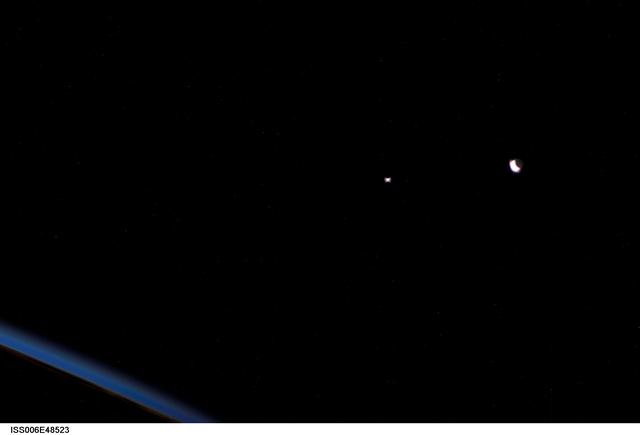
Astronomy Calendar 2020: What’s Up?
It’s time once again for my annual update on special events of astronomical interest this year. Here is the Answers in Genesis Astronomy Calendar 2020.
Venus
Venus begins the year already visible in the evening sky. If you haven’t noticed it yet, Venus is the very bright "star" in the southwest. Venus emerged from behind the sun (superior conjunction) last summer. When at superior conjunction with the sun, Venus is at its greatest distance from the earth, so Venus has appeared relatively small to viewers on earth. However, as Venus approaches inferior conjunction with the sun (when it is closest to earth) in early June, Venus will continually grow in apparent size. If you have a small telescope, the first five months of 2020 offer a good opportunity to watch this gradual change in the angular size of Venus. You’ll also see Venus go through a change of phase as it moves toward inferior conjunction. At year’s opening, Venus will be a small waxing gibbous phase, with Venus appearing round with a small sliver of dark on one side. As Venus approaches the earth, not only will Venus gradually appear larger, but the dark portion of Venus will increase.
In late April, Venus will be at greatest brilliancy.
On March 24, Venus will be at greatest eastern elongation from the sun at 46 degrees. Venus will set nearly two-and-a-half hours after twilight ends, leaving Venus in a dark sky. At greatest elongation, Venus appears half lit. After greatest elongation, Venus will become an ever-thinner crescent at it approaches inferior conjunction. In late April, Venus will be at greatest brilliancy. By late May, Venus will make its plunge toward inferior conjunction, rapidly making it disappear from the evening sky. After inferior conjunction, Venus will give an encore performance, but in reverse order. By the second week in June, you ought to be able to glimpse Venus in the eastern early morning sky. Through a telescope, it will be a crescent nearly an arc minute across. Each day the size of the crescent will shrink as the crescent thickens. Around the tenth of July, Venus will be at greatest brilliancy once again, and on August 13, Venus will be at greatest western elongation (46 degrees) from the sun, when it once again will appear half lit. Thereafter, Venus will slowly appear to approach the sun as it heads toward superior conjunction with the sun in spring of next year. Watching the progress of Venus for much of 2020 through a telescope would make an excellent home school project.

Crescent moon (right) and Venus, photographed by Expedition six from the International Space Station (ISS) with Earth’s horizon on lower left. Photo credit: NASA
Venus is bright enough so that when it is some angular distance from the sun, it can be seen during the day. The difficulties are knowing exactly where to look in the sky and how to get your eyes focused at infinity. The best time to do so is when Venus appears close to the crescent moon, for in a clear sky the crescent is relatively easy to find. There are several opportunities to do this in 2020. The first time that you can do this is the evenings of January 27 and 28. On the 27th, Venus will be to the upper left of the waxing crescent moon, while on the 28th, Venus will be to the lower right of the moon. The same thing is possible on the evenings of February 26 and 27, March 27 and 28, and April 25, 26, and 27. Each time, Venus will be to the left of the moon on the earlier date and right of the moon on the later date. On April 26, Venus will be very close to the moon. You should attempt looking for Venus in late afternoon when you can easily spot the waxing crescent moon east of the sun. It is important that the sky be very clear—any clouds will dim the light of Venus and make the sky brighter than normal, rendering Venus invisible.
One also can spot Venus near the waning crescent moon on clear mornings after the sun has risen. Morning daytime viewing of Venus has the advantage that you can easily see Venus and the moon together in the pre-sunrise sky so that you will better know where to look for Venus after the sun rises. Venus will be very close to the moon on the mornings of June 19, July 17, September 14. On July 18, Venus will be to the lower left of the moon, while on July 19, Venus will be to the upper right of the moon. Similar circumstances will exist on the mornings of August 15 and 16, September 13 and 15, October 13 and 14, and November 12 and 13.
Mercury
Being fainter and much closer to the sun than Venus, Mercury is far more difficult to see.
Being fainter and much closer to the sun than Venus, Mercury is far more difficult to see. However, there are a few good opportunities in 2020 to see it. On the evening of February 10 Mercury will be at greatest eastern elongation (18 degrees) from the sun. Look low in the southwest shortly after sunset. Mercury will be at greatest brilliancy about a week before. Mercury will be best for viewing for perhaps two weeks centered on these dates. Another evening chance to see Mercury will be in late May and early June, with greatest brilliancy near the middle of May and greatest eastern elongation (24 degrees) from the sun on June 3. A good chance to see Mercury in the morning sky will be in late July, with greatest western elongation (20 degrees) from the sun on July 22 and greatest brilliancy in early August. Another chance is in November, with greatest elongation (20 degrees) from the sun on November 10 and greatest brilliancy a few days later. For the morning apparitions, look for Mercury before sunrise in the eastern sky in July and the southeastern sky in November.
Mars
Mars will be at opposition to the sun on October 13. Opposition is the best time to view superior planets, those planets with orbits larger than the earth’s orbit. At opposition, a superior planet is up all night and is at its closest approach to earth. This fact is particularly true for Mars, since its orbit is so close to the earth’s orbit. This closeness causes the apparent size of Mars to change dramatically. Mars is best to view with a telescope within a month or two of opposition. But Martian oppositions occur at intervals of 22 months, so most of the time Mars is very disappointing. Mars will be best viewed September through November. And because of Mars’ relatively elliptical orbit, not all its oppositions are created equal. Good oppositions of Mars are placed at intervals of 15 and 17 years. The Martian opposition in 2018 was the best since 2003. Martian opposition isn’t nearly as good in 2020, but it won’t be this good again for more than a decade.
Jupiter and Saturn
Since Jupiter and Saturn are so much farther away than Mars, it doesn’t matter that much when you look at them, though it is best when they are high in the sky.
Jupiter will be at opposition on July 13, followed by Saturn at opposition just a week later. Since Jupiter and Saturn are so much farther away than Mars, it doesn’t matter that much when you look at them, though it is best when they are high in the sky. Early evenings views will be best in late summer and into autumn. This is peak season for our stargazer events here at the Creation Museum, so these two planets will be our main attraction then. On December 21, Jupiter and Saturn will be in conjunction, appearing only 1/10 degree apart (this also is the date of the December solstice). Jupiter and Saturn come into conjunction only once every 20 years. This could make for some interesting photographs, but unfortunately on that date the two planets will be very low in the southwestern sky, rendering them very blurry.

I took this photo on August 14, 2015, from the deck in back of my house. The Perseid meteor is the bright streak. It moved upward.
The Perseid Meteor Shower
I always like to keep people abreast of the Perseid meteor shower, the strongest and most dependable shower of the year. Since it happens in summer for the Northern Hemisphere, it is very convenient for many people to enjoy the Perseids. It is best to watch for Perseids in the morning rather than the evening. The Perseids will peak on the morning of August 12. The moon will be one day past third quarter on that date, with the moon rising shortly before local midnight. Therefore, the moon’s brightness will interfere with the visibility of fainter meteors, but there ought to be plenty of brighter meteors to see that morning. While the Perseid shower peaks that one morning, the shower is spread over a few weeks. Since the moon’s brightness will be waning, it would be best to watch for it after the peak rather than before the peak. As usual, I plan to blog about anything else that comes along, so keep checking back.
Planetarium 2.0 in 2020

And of course, in 2020, I am looking forward to the completion of the planetarium upgrades that donors so graciously provided all of the much-needed funds for. Ken explained why it was needed in a blog earlier this year, and I’m happy to say that we had a gift-matching opportunity in September that we were able to take full advantage of.
For those who have visited the Creation Museum in the past two months, you’ve probably noticed that the Stargazers Planetarium has been closed. In early November, the planetarium was gutted and is undergoing a complete overhaul. The control room is being expanded, which will allow for a little more seating than before and easier operation during our live shows. We are getting a new dome, which will be tilted so that viewing will be a bit more comfortable. Even more important, we will install an entirely new computer and new projectors. Digistar 6 will replace our Digistar 5 system. The most significant improvement of the Digistar 6 system is that it uses laser lights to produce much brighter, crisper images than before. These improved images will allow even better representation of what the night sky looks like. We also plan to produce new planetarium shows to augment the two that we normally show. We plan to reopen the planetarium by spring, just in time for the large increase in attendance we experience each year after the winter doldrums. We hope you plan to visit the Creation Museum in 2020 to check it out!

Answers in Genesis is an apologetics ministry, dedicated to helping Christians defend their faith and proclaim the good news of Jesus Christ.
- Customer Service 800.778.3390
- Available Monday–Friday | 9 AM–5 PM ET
- © 2026 Answers in Genesis
